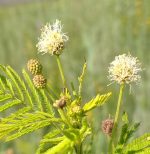 Also known as false sensitive plant and Illinois mimosa, this herbaceous perennial is a member of the pea family, Fabaceae, that also includes beans, lupine, and black locust. It is native from South Dakota and Minnesota through Colorado, New Mexico and Texas, and eastward to Ohio, Kentucky, Tennessee, and the Carolinas and into Florida where it is found on prairies, moist meadows, open wooded slopes, ravines, stream banks, roadsides and waste areas. Plant grow 24-51″ tall and have a woody caudex and longitudinally mostly unbranched grooved stems. The bipinnately compound leaves are up to 8″ long and have 8-10 pairs of leaflets that are further divided into 20-40 subleaflets 1/8′ long. The leaflets are are sensitive to external factors such as sunlight and touch and fold up when stimulated. In July and August 3′ long lateral stalks carry 1/2″ wide globose to ovoid flowerheads that look like a starburst and consist of 25-50 densely packed flowers. Each flower has 5 white petals and 5 protruding stamens with white filaments and pale yellow anther. The flowerheads are replaced by 5-15 curved and somewhat flattened seedpods 1/2″ long and containing 2-5 reddish brown seeds. The genus name, Desmanthus, comes from the Greek words desme meaning a bundle, and anthos meaning a flower and refers to the inflorescence. The specific epithet, illinoiensis, refers to geographic location of the species.
Also known as false sensitive plant and Illinois mimosa, this herbaceous perennial is a member of the pea family, Fabaceae, that also includes beans, lupine, and black locust. It is native from South Dakota and Minnesota through Colorado, New Mexico and Texas, and eastward to Ohio, Kentucky, Tennessee, and the Carolinas and into Florida where it is found on prairies, moist meadows, open wooded slopes, ravines, stream banks, roadsides and waste areas. Plant grow 24-51″ tall and have a woody caudex and longitudinally mostly unbranched grooved stems. The bipinnately compound leaves are up to 8″ long and have 8-10 pairs of leaflets that are further divided into 20-40 subleaflets 1/8′ long. The leaflets are are sensitive to external factors such as sunlight and touch and fold up when stimulated. In July and August 3′ long lateral stalks carry 1/2″ wide globose to ovoid flowerheads that look like a starburst and consist of 25-50 densely packed flowers. Each flower has 5 white petals and 5 protruding stamens with white filaments and pale yellow anther. The flowerheads are replaced by 5-15 curved and somewhat flattened seedpods 1/2″ long and containing 2-5 reddish brown seeds. The genus name, Desmanthus, comes from the Greek words desme meaning a bundle, and anthos meaning a flower and refers to the inflorescence. The specific epithet, illinoiensis, refers to geographic location of the species.
Type: Herbaceous perennial
Bloom: Globose to ovoid flowerheads of white flowers with long stamens in July and August
Size: 24-51″ H
Light:Full to partial sun
Soil: Fertile, moist to mesice, well-drained
Hardiness: Zones 5-8
Care: Low maintenance
Pests and Diseases: Susceptible to seed damage by Acanthoscelides, leaf spot by Cercospora desmanthi, physical damage by rodents, rabbits, grasshoppers, and leafhoppers
Propagation: Seed
Companion Plants: New England aster, meadow blazing star, early sunflower
Photo Credit: Thum Yorky, Wikemedia Commons
.